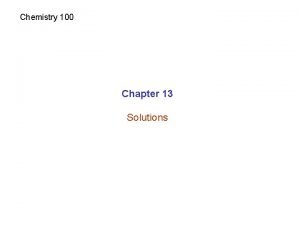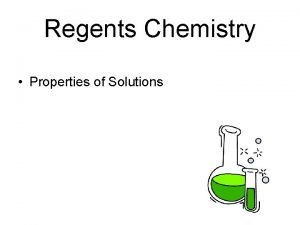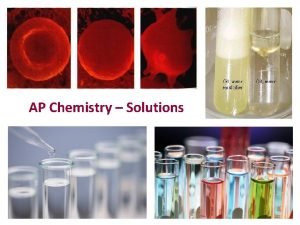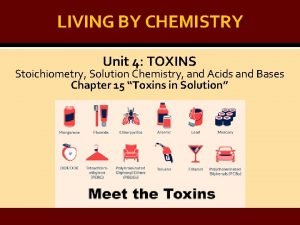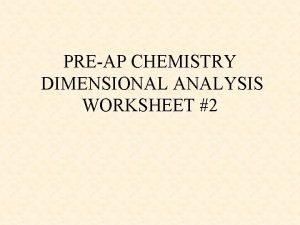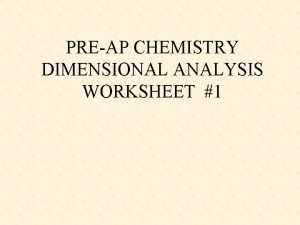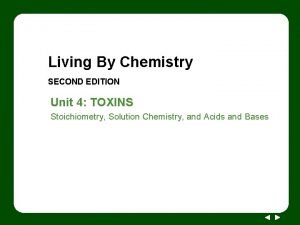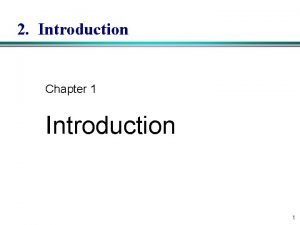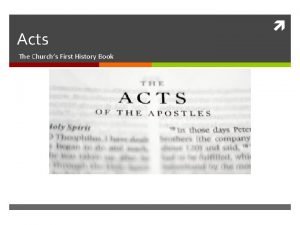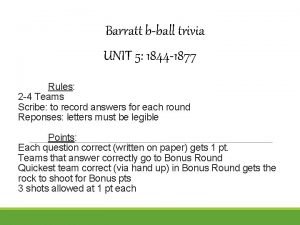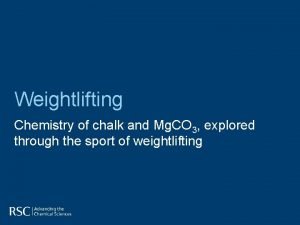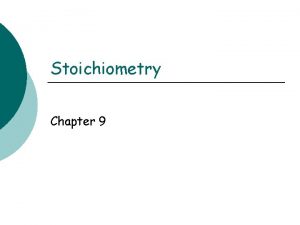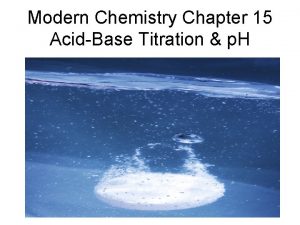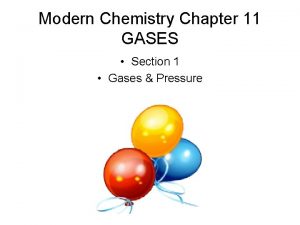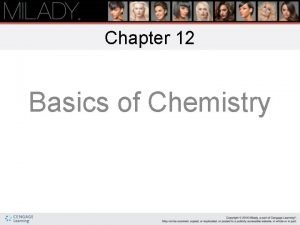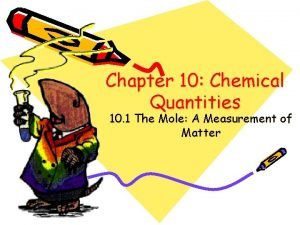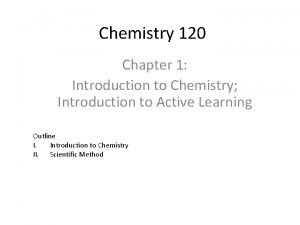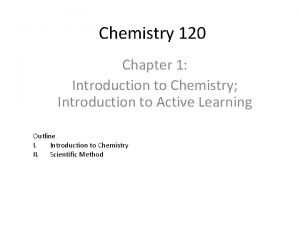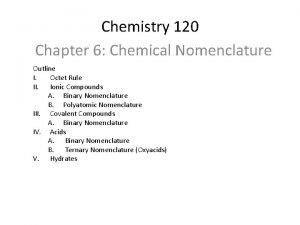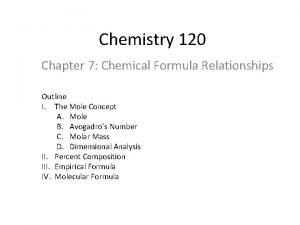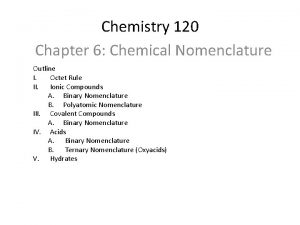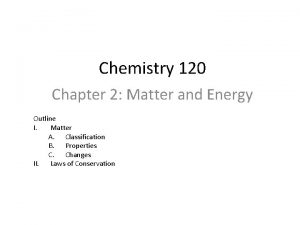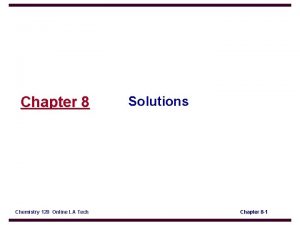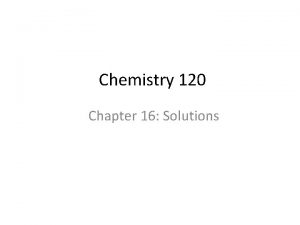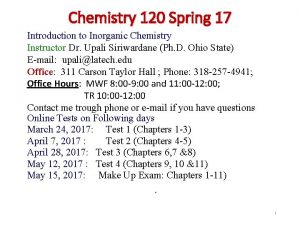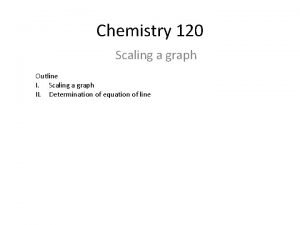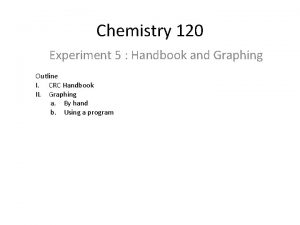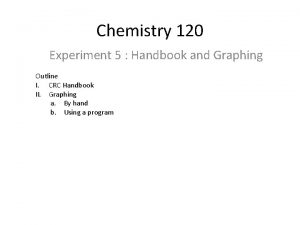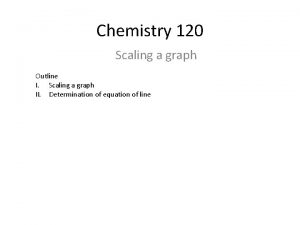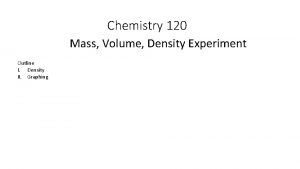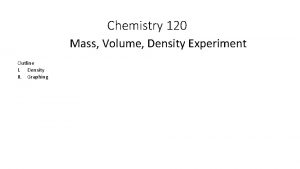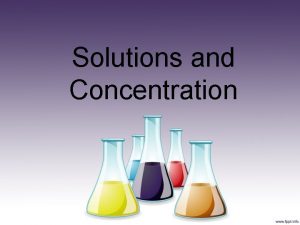Chemistry 120 Chapter 16 Solutions Outline I Solutions






















































- Slides: 54

Chemistry 120 Chapter 16: Solutions Outline I. Solutions II. Properties of Solutions III. Solubility IV. Units of Concentration V. Solution Stoichiometry VI. Colligative Properties

How do the solute and solvent mix in a solution? Figure 16 -1 p 476

How are solutions quantified?

What is the mass percent of the solution?

Example – Units of Concentration Mass Percent • What is the mass percent of a solution prepared by dissolving 30. 0 g of sodium hydroxide in 120. 0 g of water?

Example – Units of Concentration Mass Percent • An antibiotic ointment is 3. 5% neomycin. How many grams of neomycin are in a tube containing 64 grams of ointment?

How do you prepare a solution?

How do you prepare a solution? Figure 16 -15 p 490

Example – Units of Concentration Molarity • What is the molarity of a solution that contains 24. 6 g of sodium hydroxide dissolved in a total volume of 500. 0 m. L?

Example – Units of Concentration Molarity • How many grams of potassium chloride is needed to prepare 0. 250 L of 2. 00 M potassium chloride solution?

Example – Units of Concentration Molarity • Determine the molar concentrations of potassium ions and carbonate ions in a 2. 00 M potassium carbonate solution. A. 2. 00 M K+ and 2. 00 M CO 32 B. 2. 00 M K+, 2. 00 M C 4 -, 2. 00 M O 2 C. 2. 00 M K+ and 4. 00 M CO 32 D. 4. 00 M K+ and 2. 00 M CO 32 E. none of the above

Example – Units of Concentration Molarity • Determine the molar concentrations of ions in a 2. 00 M iron(III) sulfate solution. A. 2. 00 M Fe 3+ and 2. 00 M SO 42 B. 4. 00 M Fe 3+, 6. 00 M S 2 -, 24. 0 M O 2 C. 4. 00 M Fe 3+ and 6. 00 M SO 42 D. 4. 00 M Fe 3+, 6. 00 M S 2 -, 8. 00 M O 2 E. none of the above

How does concentration change during a dilution?

How does the number of solute particles change when a solution is diluted? Figure 16 -17 p 499

How do you prepare a diluted solution? Figure 16 -18 p 501

Example - Dilutions • What is the molarity of a solution prepared when 75. 00 m. L of a 4. 00 M potassium chloride solution is diluted to 500. 0 m. L?

Example - Dilutions • What volume in m. L of a 0. 20 M strontium chloride solution is needed to prepare 5. 00 m. L of a 1. 0 M strontium chloride solution?

Example – Units of Concentration Molarity • A nitric acid solution is 35. 0% nitric acid by mass and has a density of 1. 21 g/m. L. What is the molarity of the solution?

Example – Units of Concentration Molarity • Calculate the percent acetic acid in a solution of vinegar that is 3. 50 M in acetic acid and has a density of 1. 06 g/m. L.

Figure 16 -19 p 502

Example – Solution Stoichiometry • How many liters of a 1. 50 M hydrochloric acid solution will completely react with 5. 32 g of zinc?

Example – Solution Stoichiometry • What volume in m. L of a 0. 750 M sodium carbonate is required to completely react with 15. 0 m. L of 6. 00 M hydrochloric acid?

Example – Solution Stoichiometry • The antacid Amphogel contains aluminum hydroxide. Aluminum hydroxide reacts with sulfuric acid to produce aluminum sulfate and water. What is the concentration of hydroxide ions in the antacid solution, if it requires 30. 00 m. L of 6. 00 M sulfuric acid to completely react with 60. 00 m. L of Amphogel?

Example – Solution Stoichiometry • Nickel(II) chloride reacts with sodium hydroxide to produce nickel(II) hydroxide and sodium chloride. A. Write the balanced equation, total ionic equation and net ionic equation. B. How many grams of nickel(II) hydroxide are produced when 35. 0 m. L of 1. 75 M sodium hydroxide reacts with 10. 00 m. L of 5. 00 M nickel(II) chloride? C. What is the molarity of the ions that are left?

What are the common types of solutions? • Gaseous gas in gas liquid in gas • Liquid gas in liquid solid in liquid • Solid liquid in solid

How does pressure affect gas solubility?


Example - Henry’s Law • If the solubility of nitrogen is 1. 90 mg/100 m. L blood at 1. 00 atm, what is the solubility of nitrogen in a scuba diver’s blood at a depth of 155 feet where the pressure is 5. 50 atm?

Example - Henry’s Law • The solubility of chlorine gas is 0. 63 g Cl 2/100 g water at STP. What is the solubility of chlorine gas in water at 0 °C and 1200 mm Hg?

How do these liquids form solutions? Figure 16 -4 p 478

How do liquids mix into solutions?



Example - Solubility • Which of the following pairs are miscible? A. Water and ethanol, CH 3 CH 2 OH B. Hexane, CH 3(CH 2)4 CH 3 and xylene, C. Ethanol, CH 3 CH 2 OH, and xylene, D. A and B E. All of the above

How do solids mix in solutions?

What causes substances to dissolve?


What is a solvent cage? Figure 16 -6 p 479

How do ionic compounds dissociate?

How do molecular compounds dissolve?

What is a saturated solution? Figure 16 -7 p 480

What happens to a supersaturated solution if more solute is added?

How are solubility and temperature related?

How are solubility and temperature related?

Example - Solutions • What type of solution is sodium acetate at 75 °C and 115 g/100 g H 2 O? A. Saturated B. Unsaturated C. Supersaturated D. Not enough information

Example - Solutions • What type of solution is sodium acetate at 75 °C and 50 g/100 g H 2 O? A. Saturated B. Unsaturated C. Supersaturated D. Not enough information

How do colligative properties affect freezing? Figure 16 -22 p 511

Example – Colligative Properties • Calculate the freezing point of a 2. 0 m ethylene gylcol, CH 2(OH)CH 2 OH, antifreeze solution. Kf water = 1. 86 °C/m.

Example – Colligative Properties • A 1. 00 -kg sample of water contains 0. 500 mol of Na 3 PO 4. What is the freezing point of the solution? Kf water = 1. 86 °C/m.

Example – Colligative Properties • Calculate the boiling point of a 2. 0 m ethylene gylcol, CH 2(OH)CH 2 OH, antifreeze solution. Kb water = 0. 512 °C/m.

Example – Colligative Properties • When 200. mg of linalool, a fragrant compound extracted from cinnamon oil, was added to 50. 0 g of camphor, Kb water = 5. 16 °C/m. , it raised the boiling point of the camphor by 0. 144 °C. What is the molar mass of the linalool?

How does osmosis work?

How does osmosis work?

How does solution concentration affect red blood cells? isotonic hypertonic hypotonic
 120*120 px
120*120 px 100+80+40
100+80+40 What is the main outline for ac 120-16e?
What is the main outline for ac 120-16e? Chapter 12 review solutions section 1
Chapter 12 review solutions section 1 Chapter 13 mixtures and solutions answers
Chapter 13 mixtures and solutions answers Sandwich
Sandwich Functional groups ib chemistry
Functional groups ib chemistry Inorganic chemistry vs organic chemistry
Inorganic chemistry vs organic chemistry Solutions chemistry regents questions
Solutions chemistry regents questions Modern chemistry solutions
Modern chemistry solutions Ap chemistry solutions
Ap chemistry solutions Living by chemistry solutions
Living by chemistry solutions Dimensional analysis worksheet 2
Dimensional analysis worksheet 2 Chemistry metric dimensional analysis worksheet answers
Chemistry metric dimensional analysis worksheet answers What is catalystfive
What is catalystfive Chapter 6 chemistry in biology
Chapter 6 chemistry in biology Labeling theory
Labeling theory Romans outline by chapter
Romans outline by chapter Research proposal
Research proposal Give me liberty chapter 27
Give me liberty chapter 27 Secondary data
Secondary data Chapter 38 a world without borders outline
Chapter 38 a world without borders outline Vbscript
Vbscript The hunger games chapter 10 questions
The hunger games chapter 10 questions Chapter 31 societies at crossroads
Chapter 31 societies at crossroads Ap world history chapter 28 outline
Ap world history chapter 28 outline Chapter 2 learning goals outline sociology answers
Chapter 2 learning goals outline sociology answers Chapter 1 outline
Chapter 1 outline Chapter 1 outline
Chapter 1 outline Chapter 30
Chapter 30 Chapter 2 outline
Chapter 2 outline Acts outline
Acts outline 24 chapter outline
24 chapter outline 24 chapter outline
24 chapter outline Forty niners apush
Forty niners apush Approach chemistry chalk chapter
Approach chemistry chalk chapter Chemistry chapter 9 stoichiometry
Chemistry chapter 9 stoichiometry Organic chemistry (3rd) edition chapter 1 problem 16s
Organic chemistry (3rd) edition chapter 1 problem 16s What is organic chemistry
What is organic chemistry Chemistry chapter 9 stoichiometry
Chemistry chapter 9 stoichiometry Love formula in chemistry
Love formula in chemistry Modern chemistry chapter 15 review answers
Modern chemistry chapter 15 review answers Modern chemistry chapter 14 review answers
Modern chemistry chapter 14 review answers Modern chemistry chapter 13
Modern chemistry chapter 13 Chemistry chapter 11 gases test
Chemistry chapter 11 gases test Ap chemistry chapter 18 electrochemistry test
Ap chemistry chapter 18 electrochemistry test Chemistry matter and change chapter 7
Chemistry matter and change chapter 7 Chapter 10 chemistry study guide
Chapter 10 chemistry study guide Chapter 8 review chemical equations and reactions
Chapter 8 review chemical equations and reactions Chemistry chapter 9 chemical names and formulas
Chemistry chapter 9 chemical names and formulas Chapter 7 organic chemistry
Chapter 7 organic chemistry Chapter 24: nuclear chemistry answer key
Chapter 24: nuclear chemistry answer key Chapter 22 review organic chemistry section 1 answers
Chapter 22 review organic chemistry section 1 answers What's the difference between solution and suspension
What's the difference between solution and suspension Chemistry chapter 10 chemical quantities
Chemistry chapter 10 chemical quantities




